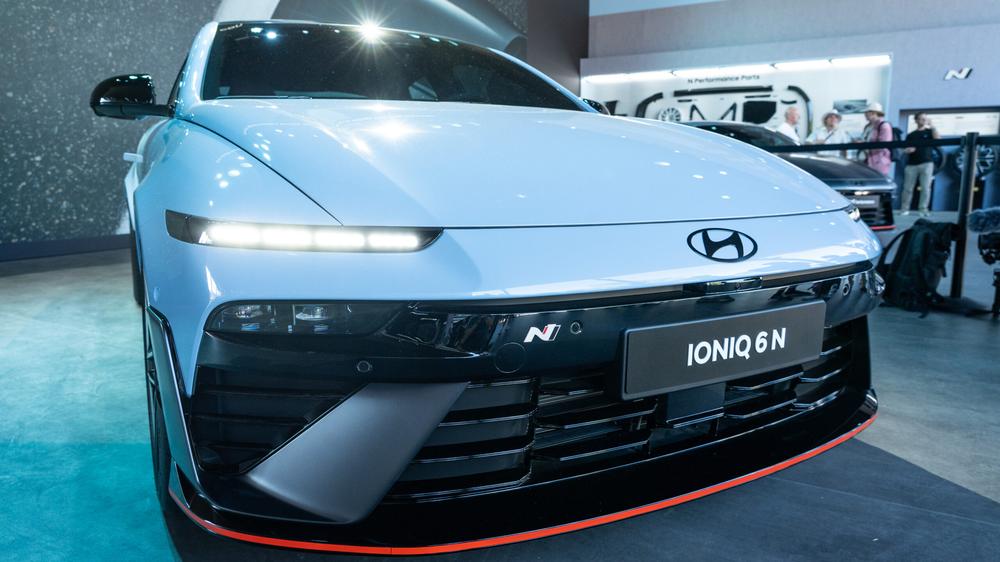Hyundai's N division is celebrating its 10th anniversary in 2025. That's not long enough to earn the cachet of other performance sub-brands, like BMW's M or Mercedes-Benz's AMG, but N has certainly developed a reputation for fun, attainable, and powder-blue cars. With the Ioniq 5 N, Hyundai's skunkworks for speed proved that it can do the impossible: make an EV that's ridiculously, irrationally fun. Now, it's trying to reproduce that magic.
Meet the Ioniq 6 N, a new big-winged, high-powered, pastel-dipped machine designed for those who cross the spectrum between a love of EVs and a need for speed. It shares much of the performance architecture of the Ioniq 5 N, including stronger motors and cooling to match, but it has some significant updates that should make it even more engaging and fun.
Let's start with what's the same: The Ioniq 6 N uses a pair of uprated electric motors to deliver 641 hp (478 kW) and 568 lb-ft (779 nm) of torque, directed to all four wheels. Not only can those motors put out big power, but they can regen it as well, with the Ioniq 6 N able to brake at up to 0.6 G before it calls in support from its physical brake. (That's about twice as much as most EVs, which usually switch over to friction brakes at 0.3 G.)
It rolls on a wheelbase that's 0.6 inches (roughly six cm) longer than the regular Ioniq 6. Yes, Hyundai went so far as to lengthen the footing on this thing to both give it more stability and make room for the 20-inch wheels wrapped in 275-section-width Pirelli P-Zero 5 tires.
Charge comes from an 84 kWh battery that provides an estimated 291 miles (469 km) of range on the WLTP cycle. That should equate to somewhere around 250 miles (400 km) of range on the EPA cycle, roughly 100 short of the non-N Ioniq 6. That power is directed through an interesting, dual-mode inverter. At lower-power situations (system output below 215 hp, or 160 kW), the car uses a silicon-carbide inverter optimized for efficiency. At higher speeds, the car switches to a less-efficient but higher-throughput silicon inverter capable of providing the current needed for peak power.
Maintaining that peak power for a full session of hot laps is a huge challenge for EVs. For the Ioniq 6 N, Joon Park, boss of Hyundai's N division, told me that the target was running upward of eight five-minute laps in Endurance mode without derating. That's plenty enough for a 20-minute session at your average track day.
The other half of the equation is getting juice back into the battery, and the Ioniq 6 N can charge at a maximum rate of 350 kW. That, Park said, would get enough juice for another 20-minute session in 15 minutes of charging—if you happen to be at a track with a suitably quick charger, which are about as rare as hen's teeth.
That's all much the same as on the 5 N. With the 6 N, though, Hyundai's engineers made some significant improvements in the car's virtual shifting, which is a huge part of what makes this series so much fun. Joon Park told me that improving the quality of the car's simulated engine notes was a huge priority. The sedan has an upgraded set of internal and external speakers dedicated to more accurately replicating the myriad sounds that comprise the harmony of internal combustion.
Less F-Zero, More WRC
The engineering team sampled the raspy, rattling, popping cacophony of the company's i20 WRC car to create a fantastic aural fanfare to accompany the launch control that precedes a 3.2-second 0 to 62 mph (100 kph) sprint. There are three separate engine sounds, each higher fidelity than those found in the 5 N. (Park didn't rule out the improved acoustics coming to the 5 N at some point, but it's not on the roadmap for now.)
Those sounds aren't radically different from what we heard before, but they are noticeable improvements. They are still video game-like but far more modern than before—think PS4 vs. PS2. That sound helps to accentuate the N e-Shift system, which simulates virtual gears. For the 6 N, those gears have been shortened quite a bit, pretend ratios that will have you reaching for the right paddle more often when blasting out of tighter corners.
In addition to the new sound, the shape of the 6 N is obviously quite a bit different than that of the SUV-silhouette of the Ioniq 5. Being a sedan means having a trunk, and on that trunk is a mighty large wing with a dramatic curving profile to match the sculpted edges at the rear of the 6 N.
Not big enough? Don't worry, Hyundai is launching a new line of N Performance parts, enabling buyers to swap on a positively massive rear wing that follows the trend of gooseneck mounting, a design popularized by modern GT racing.
Big wings and EVs don't usually mix, since the priority is usually aerodynamics and not downforce. However, Eduardo Ramirez, Chief Designer of Hyundai Design Europe, told me that despite the extra aerodynamic volume, the bigger optional wing doesn't create extra drag. So if you crave that low-key GT3 look but worry about a big-time range hit, follow your heart.
The final change from the 5 N is so subtle that I didn't even notice it at first, but the division's distinctive Performance Blue paint now shines through a white pearl coating. I'm a big fan of the N series' blue/red/black liveries, and the extra sheen here just makes things look that much more premium.
Speaking of premiums, the big question on my mind is how much the Hyundai Ioniq 6 N will cost. Prices of everything are a bit turbulent, with shifting tariffs and credit situations, but right now, you'll have to spend an extra $23,600 over the $42,600 MSRP of an Ioniq 5 if you want to step up to an Ioniq 5 N.
If that same delta is maintained for this new model, given the Ioniq 6 starts at $37,850, you'll be looking at somewhere around $60,000 for an Ioniq 6 N. But the market has changed significantly since the 5 N was introduced in 2023, so it's anyone's guess which numbers will be stuck on the glass of the 6 N when it hits American dealerships, assuming import tariffs don't turn this blueberry into forbidden fruit.
When might you be able to get one? Nobody's talking about that yet, either, but hopefully, Hyundai won't keep us waiting long.

 Battlefield 6 devs respond to backlash over controversial class system change
Battlefield 6 devs respond to backlash over controversial class system change